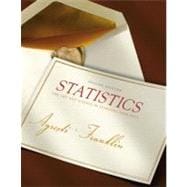
Note: Supplemental materials are not guaranteed with Rental or Used book purchases.
Purchase Benefits
What is included with this book?
Christine Franklin is a Senior Lecturer and Honors Professor in the Department of Statistics at the University of Georgia. She has been a member of college faculty in statistics for almost 30 years. Chris has been actively involved at the national level with promoting statistical education at the K-12 level and college undergraduate level since the 1980's. She is currently the Chief Reader for AP Statistics and has developed three masters level courses at UGA in data analysis for elementary, middle school, and secondary teachers. Chris was the lead writer for the ASA endorsed Guidelines for Assessment and Instruction in Statistics Education (GAISE) Report: A Pre-K-12 Curriculum Framework.
Chris has been honored by her selection as a Fellow of the American Statistical Association, the 2006 Mu Sigma Rho National Statistical Education Award recipient for her teaching and lifetime devotion to statistics education, and numerous teaching and advising awards at UGA. Chris has written more than 30 journal articles and resource materials for textbooks.
| Gathering and Exploring Data | |
| Statistics: The Art and Science of Learning from Data | |
| How Can You Investigate Using Data? | |
| We Learn about Population Using Samples | |
| What Role do Computers Play in Statistics? | |
| Chapter Summary | |
| Chapter Exercises | |
| Exploring Data with Graphs and Numerical Summaries | |
| What Are the Types of Data? | |
| How Can We Describe Data using Graphical Summaries? | |
| How Can We Describe the Center of Quantitative Data? | |
| How Can We Describe the Spread of Quantitative Data? | |
| How Can Measures of Position Describe Spread? | |
| How Can Graphical Summaries Be Misused? | |
| Answers to Chapter Figure Questions | |
| Chapter Summary | |
| Chapter Exercises | |
| Association: Contingency, Correlation, and Regression | |
| How Can We Explore the Association between Two Categorical Variables? | |
| How Can We Explore the Association between Two Quantitative Variables? | |
| How Can We Predict the Outcome of a Variable? | |
| What are Some Cautions in Analyzing Associations? | |
| Answers to Chapter Figure Questions | |
| Chapter Summary | |
| Chapter Exercises | |
| Gathering Data | |
| Should We Experiment or Should We Merely Observe? | |
| What Are Good Ways and Poor Ways to Sample? | |
| What Are Good Ways and Poor Ways to Experiment? | |
| What Are Other Ways to Perform Experimental and Nonexperimental Studies? | |
| Answers to Chapter Figure Questions | |
| Chapter Summary | |
| Chapter Exercises | |
| Part 1 Review | |
| Part 1 Summary | |
| Part 1 Exercises | |
| Probability and Probability Distributions | |
| Probability in our Daily Lives | |
| How Can Probability Quantify Randomness? | |
| How Can We Find Probabilities? | |
| Conditional Probability: What's the Probability of A, Given B? | |
| Applying the Probability Rules | |
| Answers to Chapter Figure Questions | |
| Chapter Summary | |
| Chapter Exercises | |
| Probability Distributions | |
| How Can We Summarize Possible Outcomes and Their Probabilities? | |
| How Can We Find Probabilities for Bell-Shaped Distributions? | |
| How Can We Find Probabilities when Each Observation has Two Possible Outcomes? | |
| Answers to Chapter Figure Questions | |
| Chapter Summary | |
| Chapter Exercises | |
| Sampling Distributions | |
| How Likely Are the Possible Values of a Statistics? | |
| The Sampling Distribution | |
| How Close Are Sample Means to Population Means? | |
| How Can We Make Inferences about a Population? | |
| Answers to Chapter Figure Questions | |
| Chapter Summary | |
| Chapter Exercises | |
| Part 2 Review | |
| Part 2 Summary | |
| Part 2 Exercises | |
| Inference Statistics | |
| Statistical Inference: Confidence Intervals | |
| What Are Point and Interval Estimates of Population Parameters? | |
| How Can We Construct a Confidence Interval to Estimate a Population Proportion? | |
| How Can We Construct a Confidence Interval to Estimate a Population Mean? | |
| How Do We Choose the Sample Size for a Study? | |
| How Do Computers Make New Estimation Methods Possible? | |
| Answers to Chapter Figure Questions | |
| Chapter Summary | |
| Chapter Exercises | |
| Statistical Inference: Significance Tests about Hypotheses | |
| What Are the Steps for Performing a Significance Test? | |
| Significance Tests about Proportions | |
| Significance Tests about Means | |
| Decisions and Types of Errors in Significance Tests | |
| Limitations of Significance Tests | |
| How Likely is a Type II Error (Not Rejecting H0, Even though it's False)? | |
| Answers to Chapter Figure Questions | |
| Chapte<$$$> | |
| Table of Contents provided by Publisher. All Rights Reserved. |
The New copy of this book will include any supplemental materials advertised. Please check the title of the book to determine if it should include any access cards, study guides, lab manuals, CDs, etc.
The Used, Rental and eBook copies of this book are not guaranteed to include any supplemental materials. Typically, only the book itself is included. This is true even if the title states it includes any access cards, study guides, lab manuals, CDs, etc.